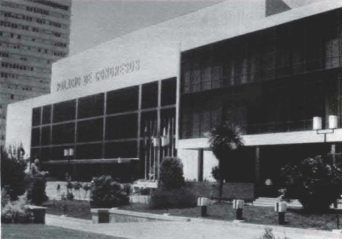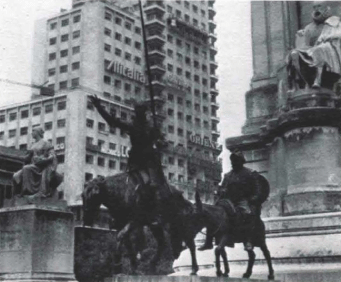in Madrid
vom 4. bis 7. Juni 1974
H. J. Körner
Diejenigen Teilnehmer an der Madrider Tagung, die ihren Jahresurlaub später antraten und damit lediglich in den zweifelhaften Genuß des diesjährigen europäischen Schlechtwetters kamen, werden sich sicher besonders gern der schönen Tage in Madrid erinnern. Aber auch in anderer Hinsicht war der Besuch lohnend, denn Madrid hat sowohl moderne Prachtstraßen wie eine hübsche Altstadt und außerdem eine landschaftlich wie kulturell interessante Umgebung

Tagungsstätte![]() Meeting hall
Meeting hall
The 36th EAEG Meeting in Madrid
June 4 to June 7, 1974
For those participants of the Madrid meeting who had a rainy European vacation later in the summer, the sun-filled days in Madrid will be memorable. The elegant avenues of Madrid, a charming old inner city, rurallandscape, and pi aces of cultural interest in the surroundings made the visit to this metropolis worthwhile also in these respects.
Die Tagung der European Association of Exploration Geophysicists war diesmal von 600 Teilnehmern besuchtBegleitpersonal nicht eingerechnet. Sie fand im hochmodernen Palacio de Congresos y Exposiciones statt. Nach der offiziellen Eröffnung am Dienstag Vormittag wurden von Dienstag Nachmittag bis zum Freitag Nachmittag 64 Vorträge in je zwei Parallelsitzungen gehalten. 34 Vorträge befaßten sich mit seismischen Problemen, die anderen 30 Vorträge verteilten sich relativ gleichmäßig auf Magnetik, Gravimetrie und Geo-Elektrik.
Mitarbeiter der PRAKLA-SEISMOS hielten die folgenden 3 Vorträge, von denen wir kurze Inhaltsangaben bringen:
In the modern Palacio de Congreso y Exposiciones, 600 participants (excluding the attending persons) assembled for the Meeting of European Association of Exploration Geophysicists. After the official opening on Tuesday morning, 64 papers were delivered, two at a time, from Tuesday afternoon until Friday afternoon. 34 papers dealt with seismic problems, the remaining 30 dealt in about equal parts with the sciences magnetics, gravimetrics and geoelectrics.
The representatives of PRAKLA-SEISMOS delivered the following three papers, here summarized:
R. Bortfeld, R. Brannies, W. Houba und O. Ristow
Es wird ein seismisches dreidimensionales Schieß-und Processing-Verfahren vorgestellt, das -zusätzlich zu Zeitfunktionen wie Stapelgeschwindigkeit, Neigung im Profil, Kohärenz usw. -bei jedem Sampie jedes Untergrundpunktes die Neigung senkrecht zur Profillinie gibt.
Die Schießmethode unterscheidet sich nur leicht vom konventionellen COP-Schießen, auch die Kosten sind kaum größer. Bei leicht zugänglichem Gelände beiderseits der Profillinie werden die Schußpunkte der konventionellen COP-Aufstellung in verschiedenen Entfernungen von der Geophonlinie senkrecht zu ihr willkürlich angeordnet, wobei ihr mittlerer Abstand von der Profillinie etwa 50 m beträgt. Bei schwierigem Gelände (wie z. B. im Dschungel) werden Geophone und Schußpunkte (nach Th. Krey) auf einer Zickzacklinie angeodnet. Bei Seemessungen werden zwei identische Luftpulserarrays verwendet, die im Abstand von 40 m links und rechts des Schiffes abwechselnd gezündet werden.
Die Bearbeitung der Daten geschieht in der COP-Spur-Reihenfolge. Bei jedem Sam pie jedes Untergrundpunktes wird die Querneigung direkt bestimmt ohne wirkliche Querprofile heranziehen zu müssen. Dies wird erreicht durch spezialstatistische Updating-Methoden.
Die Querneigung wird mit zwei Verfahren dargestellt, entweder in künstlichen kleinen Querprofilen oder durch Neigungslinien für ausgewählte Horizonte. Die Methode wurde mittels Beispielen erläutert.
A seismic three-dimensional shooting and processing procedure was presented that yields - in addition to time-functions such as stacking velocity, in-line dip, coherence, etc. - at every sampie of every subsurface point the dip perpendicular to the line of surveying.
The shooting method differs only slightly from conventional COP-shooting, and also the cost differs only slightly. Where offline shot-Iocations can easily be accessed we displace the shots of the conventional COP-setup by smalI, arbitrary, varying distances perpendicular to the line of phones. The average offline-offset is about 50 m. In the case of difficult field conditions (as for instance in the jungle) we distort (after TH. Krey) the straight line setup of shots and geophones of the conventional COP-method to a zig-zag line. With marine surveys we use two identical airgun arrays, held at 40 m (say) distance to the left and to the right of the boat by outriggers, popping in turns.
Processing of the data works with COP-trace gathers. At every sampie of every subsurface point we determine the cross-dip directly, without need to stack neighbouring sections. This is done by special statistical updating methods. The cross-dip is displayed in two ways, by short artificial crosslines, and by graphic bar representations for selected horizons.
The method has been illustrated by examples.
O. Ristow, R. Bortfeld, R. Brannies
Die Bestimmung der dynamischen und reststatischen Korrekturen kann mit Hilfe einer Updating-Methode durchgeführt werden. Für einen Reflexionsuntergrundpunkt seien folgende Zeitfunktionen gegeben: Stapelgeschwindigkeit, Neigung, Kohärenz und die sogenannte Referenzspur. Die Referenzspur ist eine unter Berücksichtigung der Neigungen über mehrere Reflexionsuntergrundpunkte gemittelte seismische Spur. Sie enthält die globale seismische Information, aber nicht die seismische Fein-I nformation. Die seismischen Spuren eines benachbarten Untergrundpunktes werden nun mit der Referenzspur verglichen, indem Zeitdifferenzen zwischen den Reflexionen gemessen werden. Die im allgemeinen kleinen Zeitdifferenzen werden dazu benutzt, um die Stapelgeschwindigkeitsfunktion und die Neigungsfunktion zu verbessern (eng!.: to update). Aus den Zeitdifferenzen lassen sich ebenfalls Aussagen über die reststatischen Korrekturen machen
The determination of dynamic corrections and residual static corrections can be performed by means of an updating method. We build at every subsurface point the time-function of the stacking velocity and of the dip, together with a modeltrace (reference trace). The reliability of these functions is given by the time-varying function of the coherency.
The model-trace contains the seismic global information for a subsurface point and its vicinity. The model-trace is of considerable reliability. It is used to predict the fjeld traces.
The predicted field trace is compared with the actually measured seismic trace, yielding time-variant, time-shifts and coherencies. The time-shifts are split into residual statics, velocity changes and dip changes. The splitting is performed using statistical methods. If e. g. the time-shifts are not changing with time, the shift will be looked at as a residual static correction. After having subtracted the residual static correction, the residual shift can be distributed into a dip change, a velocity change, and noise.
The dip-trace, the velocity-trace, the model-trace, as weil as the coherency-trace are continuously updated in this fashion. The residual statics thus found are separated into a geophonecorrection, a shot-correction and into a component that is not surface-consistent.
W. Houba, D. Jurczyk, H. Koitka
Von der Vielzahl der auf Amplitude und Form des seismischen Signals einwirkenden Parameter lassen sich nur wenige in einfacher Weise beschreiben. Bei seeseismischen Aufnahmen sind einige von diesen Einflüssen weitgehend konstant über die Länge eines Meßprofils. Daher läßt sich hier eine Bearbeitung nach wahren Amplituden problemlos durchführen. Bei Landmessungen bringen die von Meßpunkt zu Meßpunkt wechselnden Einflüsse von Schuß und Geophon für die Ermittlung der wahren Amplituden zusätzliche Probleme. Dennoch ist es möglich, die registrierte seismische Spur unter gewissen Voraussetzungen bezüglich der Störsignale auf ihre wahren Amplitudenverhältnisse zu reduzieren. Hauptsächlich drei Größen werden für den Amplitudenabfall verantwortlich gemacht und bei der Kompensation berücksichtigt:
- sphärische Divergenz
- Absorption
- Schuß-und Geophoneinflüsse
Real Amplitude Processing of seismic data has been weil and broadly accepted by the Industry. However, only very few of the parameters affecting the amplitude of a seismic wave are easily handled. In marine seismics some of these factors can be assumed to be constant along the line. Real Amplitude Processing of marine data may therefore be performed nearly without problems. With Real Amplitude Processing of land data additional problems arise due to the trace-varying effects of shot and geophone.
A routine processing procedure was presented which took account of these trace-varying effects (as weil as of the amplitude decay by absorption):
- spherical divergence is compensated in a well-known manner;
- absorption and attenuation effects of higher order are determined by statistical methods based on a number of neighbouring traces;
- noise is being detected and eliminated;
- the amplitude level is controlled by shot-and geophone factors.
The effectiveness of the procedure has been demonstrated by several examples.
Es darf hier erfreulicherweise vermerkt werden, daß alle drei Vorträge großen Widerhall fanden, denn sie waren ein Beitrag zu den Themen "3D-Verfahren", "Statische Korrekturen", "Wahre Amplituden", also Themen die die Seismiker z. Z. besonders beschäftigen. Wer etwas eingehender mit den Programmen der PRAKLA-SEISMOSDatenverarbeitung vertraut ist, weiß, daß die beiden ersten Probleme mit einer Weiterentwicklung des ASP-Systems und das dritte Problem mit einer Weiterentwicklung des Real Amplitude Processing verbunden sind.
Es gab eine große Zahl von erwähnenswerten Vorträgen. Der interessierte Leser dieser Zeilen kann entsprechende Kurzfassungen in einer der nächsten Ausgaben von "Erdöl, Erdgas + Petrochemie" nachlesen. Alle Vorträge machten jedoch klar -und das darf hier wohl ebenfalls vermerkt werden -, daß sich der Standard der großen geophysikalischen Kontraktorfirmen praktisch nicht unterscheidet.
Parallel zur Tagung fand wieder eine Ausstellung mit ca. 60 Ausstellern statt, an der sich PRAKLA-SEISMOS mit einem der größten Stände beteiligte. Besonders für die Themen ASP, Bearbeitung wahrer Amplituden und Vibroseis war eine Reihe neuer Schautafeln entstanden, die zusammen mit älteren Tafeln wieder einmal die Breite der von PRAKLA-SEISMOS angebotenen geophysikalischen Messungen dokumentierte. Von den insgesamt 28 spezifischen Schautafeln wurden inszwischen 20 im PRAKLASEISMOS-Report 3174 abgedruckt. Wie so oft erwies sich unser Ausstellungsstand als das beste Forum zur Anknüpfung und Pflege von Kontakten.

Madrid, eine Stadt der Gegensätze:
Denkmal des weltfremden Idealisten Don Ouichotte
vor einem Wolkenkratzer
Madrid, a town of contrasts:
The monument of the solitary idealist Don Ouixote
before a sky-scraper
We are pleased to note that all three papers had a great response from the audience. The themes "3D-Processing", "Static Corrections", and "Real Amplitudes" are of special interest to today's seismologists. Those who are familiar with the PRAKLA-SEISMOS processing programs know that the first two themes are related to the further development of the ASP-system and the third to the further development of Real Amplitude Processing.
There were a great number of papers worth mentioning and interested readers will find summaries in one of the next editions of "Erdöl, Erdgas + Petrochemie". All the papers made clear that there is virtually no difference in standard between the large geophysical contractors. An exhibition also took place at the time of the meeting with 60 exhibitors, among them PRAKLA-SEISMOS with one of the largest booths. The numerous boards on our booth, increased by se ries of new boards on the themes ASP, Real Amplitude Processing and Vibroseis processing documented anew the extent of the geophysical services offered by PRAKLA-SEISMOS. In the PRAKLA-SEISMOS Report 3174, 20 of the total 28 boards were presented. As proved so often in the past, the exhibition booth is the best opportunity for forming new contacts and preserving the old.
